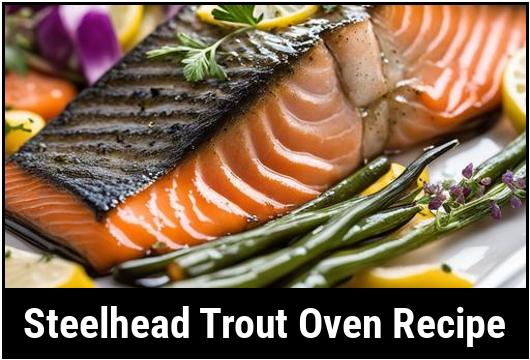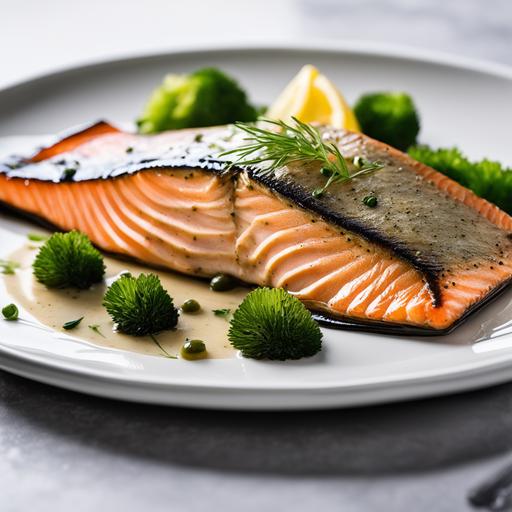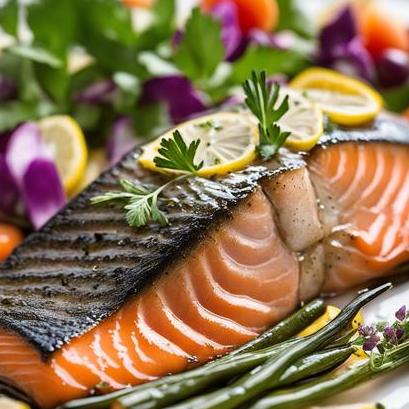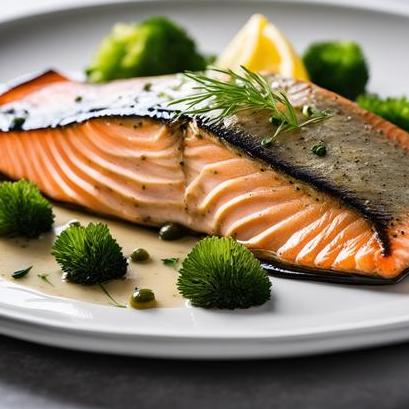
Steelhead Trout Oven Recipe: A Comprehensive Guide
Are you looking for a mouthwatering seafood dish to impress your friends and family? Look no further than the steelhead trout! Known for its delicate flavor and tender flesh, this versatile fish is a favorite among seafood enthusiasts. In this comprehensive guide, we’ll delve into every aspect of cooking steelhead trout in the oven, from selecting the freshest fillets to achieving the perfect doneness. So roll up your sleeves and get ready to learn everything you need to know about preparing a delicious steelhead trout feast!
1. Understanding the Food Science behind Steelhead Trout
Before we dive into the culinary details, let’s explore the food science behind steelhead trout. Steelhead trout, also known as Oncorhynchus mykiss, belongs to the salmonid family. Its vibrant pink flesh owes its color to the presence of a natural pigment called astaxanthin, which is derived from the fish’s diet. This pigment not only gives the fish its beautiful hue but also contributes to its rich nutritional profile.
Steelhead trout is an excellent source of omega-3 fatty acids, which are known to promote heart health and reduce inflammation in the body. It is also packed with vitamins B6, B12, and D, as well as minerals like potassium and selenium. Consuming steelhead trout regularly can have numerous health benefits and contribute to a well-balanced diet.
2. Selecting the Freshest Steelhead Trout Fillets
When it comes to cooking seafood, freshness is key. Follow these tips to ensure you select the freshest steelhead trout fillets for your oven recipe:
-
Opt for whole fish: Whole steelhead trout gives you the advantage of inspecting the fish’s eyes, skin, and gills. Look for clear, bright eyes and shiny, intact skin. The gills should be pink or deep red, indicating freshness.
-
Check for firmness: Gently press the flesh of the fish; it should feel firm and bounce back slightly when touched.
-
Smell test: Fresh steelhead trout has a mild, slightly briny aroma. If it smells off or overly fishy, it may not be fresh.
-
Trust your fishmonger: Consult your local fishmonger for advice on the best day to buy steelhead trout. They can guide you on which days the fish is delivered to ensure maximum freshness.
3. Cleaning and Preparing Steelhead Trout Fillets

Once you’ve selected your fresh steelhead trout fillets, it’s time to prepare them for the oven. Follow these steps for efficient cleaning and preparation:
Cleaning the Steelhead Trout
-
Rinse the fillets: Hold the fillets under cold running water to remove any dirt or loose scales. Pat them dry with a paper towel.
-
Descale (optional): If your fillets still have scales, remove them using a fish scaler or a knife. Scale removal is optional, as steelhead trout scales are quite thin and not always bothersome in the final dish.
-
Trim the fins (optional): Using kitchen shears, trim any exposed fins or stray bones to ensure a clean and professional look.
Preparing the Steelhead Trout
-
Seasoning: Apply your preferred seasonings according to personal taste and the recipe you’re following. Common choices include salt, pepper, lemon zest, fresh herbs like dill or parsley, and a drizzle of olive oil.
-
Resting time: Allow the fillets to rest for at least 10-15 minutes after seasoning to let the flavors penetrate the flesh.
-
Preheating the oven: Preheat your oven to 400°F (200°C) to ensure a consistent cooking temperature.
4. Tips for Cooking Steelhead Trout in the Oven

Achieving a perfectly cooked steelhead trout requires a delicate balance of temperature and time. Follow these tips to ensure your dish turns out magnificently:
Oven Temperature and Cooking Time
-
Cooking steelhead trout at a high temperature, such as 400°F (200°C), helps to seal in the moisture and achieve a beautiful golden crust.
-
The cooking time depends on the thickness of the fillets. As a general guideline, cook the fish for 4-6 minutes per 1/2 inch (1.27 cm) thickness. However, factors such as the oven’s actual temperature and the starting temperature of the fish can influence the cooking time, so it’s essential to use a thermometer to ensure proper doneness.
Using a Thermometer for Doneness Checks
-
The best way to determine if your steelhead trout is cooked to perfection is by using an instant-read thermometer. Insert the thermometer into the thickest part of the fish, avoiding the bone. The safe internal temperature for cooked fish is 145°F (63°C).
-
For a moist and flaky texture, remove the fish from the oven when it reaches an internal temperature of 135°F (57°C). Carryover cooking will continue to raise the temperature while the fish rests, reaching the desired 145°F (63°C).
Resting and Carrying Over Cooking
-
Once the trout reaches the desired temperature, remove it from the oven and let it rest on a cutting board for 5-10 minutes. This resting period allows the juices to redistribute, resulting in a moist and flavorful fillet.
-
Remember that carryover cooking will occur during the resting time, so remove the trout from the oven just shy of the target temperature. This ensures you don’t overcook the fish, preserving its delicate texture.
5. Steelhead Trout Oven Recipe: Grilled Lemon Herb Steelhead

Now that we’ve covered the essential culinary aspects, it’s time to put everything into practice with a delicious recipe. Follow this delightful Grilled Lemon Herb Steelhead recipe, and your taste buds will thank you!
Ingredients:
-
2 steelhead trout fillets, skin-on
-
2 tablespoons olive oil
-
2 tablespoons freshly squeezed lemon juice
-
1 tablespoon chopped fresh dill
-
1 tablespoon chopped fresh parsley
-
1 garlic clove, minced
-
Salt and pepper to taste
-
Lemon slices for garnish
Instructions:
-
Preheat the oven to 400°F (200°C).
-
In a small bowl, combine the olive oil, lemon juice, chopped dill, chopped parsley, minced garlic, salt, and pepper.
-
Place the steelhead trout fillets skin-side down on a baking sheet, lined with parchment paper.
-
Brush the fillets generously with the prepared herb mixture, ensuring the flesh is completely coated.
-
Arrange a few lemon slices on top of each fillet for added flavor.
-
Put the baking sheet with the steelhead trout into the preheated oven and cook for approximately 10-12 minutes, or until the fish reaches an internal temperature of 135°F (57°C).
-
Once cooked, remove the trout from the oven and let it rest on a cutting board for 5-10 minutes.
-
Serve your Grilled Lemon Herb Steelhead accompanied by a wedge of fresh lemon and your choice of sides, such as roasted vegetables or a vibrant salad.
6. Variations and Additional Tips

While the Grilled Lemon Herb Steelhead recipe is an excellent starting point, feel free to experiment with different flavors and cooking methods. Here are a few variations and additional tips to inspire your creative culinary skills:
Variations:
-
Asian-inspired: Marinate the steelhead trout in soy sauce, ginger, garlic, and a touch of honey for a delightful Asian twist.
-
Mediterranean: Opt for a Mediterranean-style preparation by seasoning the fish with dried oregano, thyme, lemon zest, and a drizzle of extra virgin olive oil.
-
Cajun spices: For those who love a bit of heat, coat your steelhead trout fillets with a Cajun spice mix before cooking.
Additional Tips:
-
For extra moisture, you can choose to wrap your seasoned steelhead trout fillets in foil instead of placing them directly on the baking sheet.
-
Enhance the flavor by adding thinly sliced onions, garlic, or fresh herbs to the baking sheet before cooking.
-
Experiment with wood chips or a cedar plank for a smoky dimension to your steelhead trout.
In Conclusion
Steelhead trout is a culinary delight that deserves a place in your recipe repertoire. Its delicious and delicate flavor, combined with its nutritional benefits, make it a great choice for seafood lovers. With this comprehensive guide, you now have the knowledge and confidence to select the freshest fillets, clean and prepare them efficiently, cook them to perfection in the oven, and even experiment with various flavors and variations. So, head to your local market, grab some steelhead trout fillets, and embark on a flavorful adventure in the comfort of your kitchen. Bon appétit!
Sources
FAQS On Steelhead Trout Oven Recipe
What Is A Good Oven Temperature For Cooking Steelhead Trout?
Preheating the oven to 400 degrees Fahrenheit (200 degrees Celsius) is recommended for cooking steelhead trout. This temperature ensures that the fish cooks evenly and retains its moisture while developing a nice crispy skin.
How Long Should I Cook Steelhead Trout In The Oven?
The cooking time for steelhead trout in the oven depends on the thickness of the fillets or whole fish. As a general guideline, a 1-inch thick steelhead trout fillet will take about 10 to 12 minutes to cook. It is important to check for doneness by observing the fish’s internal temperature, which should reach 145 degrees Fahrenheit (63 degrees Celsius).
What Are Some Popular Seasoning Options For Steelhead Trout?
Steelhead trout has a delicate and mild flavor that can be enhanced with various seasonings. Some popular options include using a combination of lemon juice, garlic, thyme, and olive oil. Alternatively, you can opt for a simple seasoning of salt, pepper, and butter to complement the natural taste of the fish.
Should I Use A Baking Sheet Or Foil When Cooking Steelhead Trout In The Oven?
It is recommended to use a baking sheet lined with aluminum foil to cook steelhead trout in the oven. This helps to prevent the fish from sticking to the tray and makes cleaning up easier. Ensure the foil is lightly greased or sprayed with cooking oil to further reduce the chances of sticking.
How Can I Tell If The Steelhead Trout Is Cooked Properly?
The best way to determine if the steelhead trout is cooked properly is by using a food thermometer. Insert the thermometer into the thickest part of the fish, and if it reads 145 degrees Fahrenheit (63 degrees Celsius), the fish is ready. Additionally, the flesh should appear opaque and easily flake with a fork. Avoid overcooking the fish, as it can result in a dry and less flavorful outcome.



